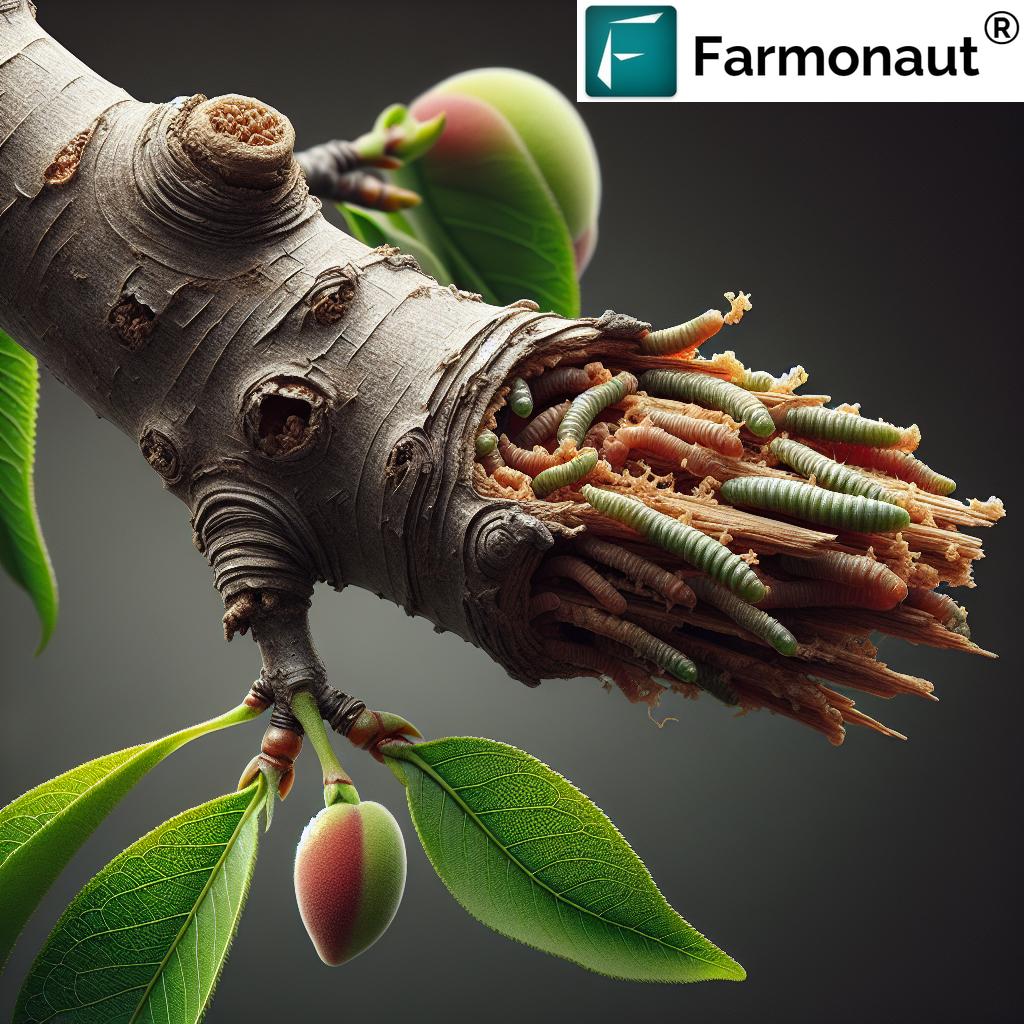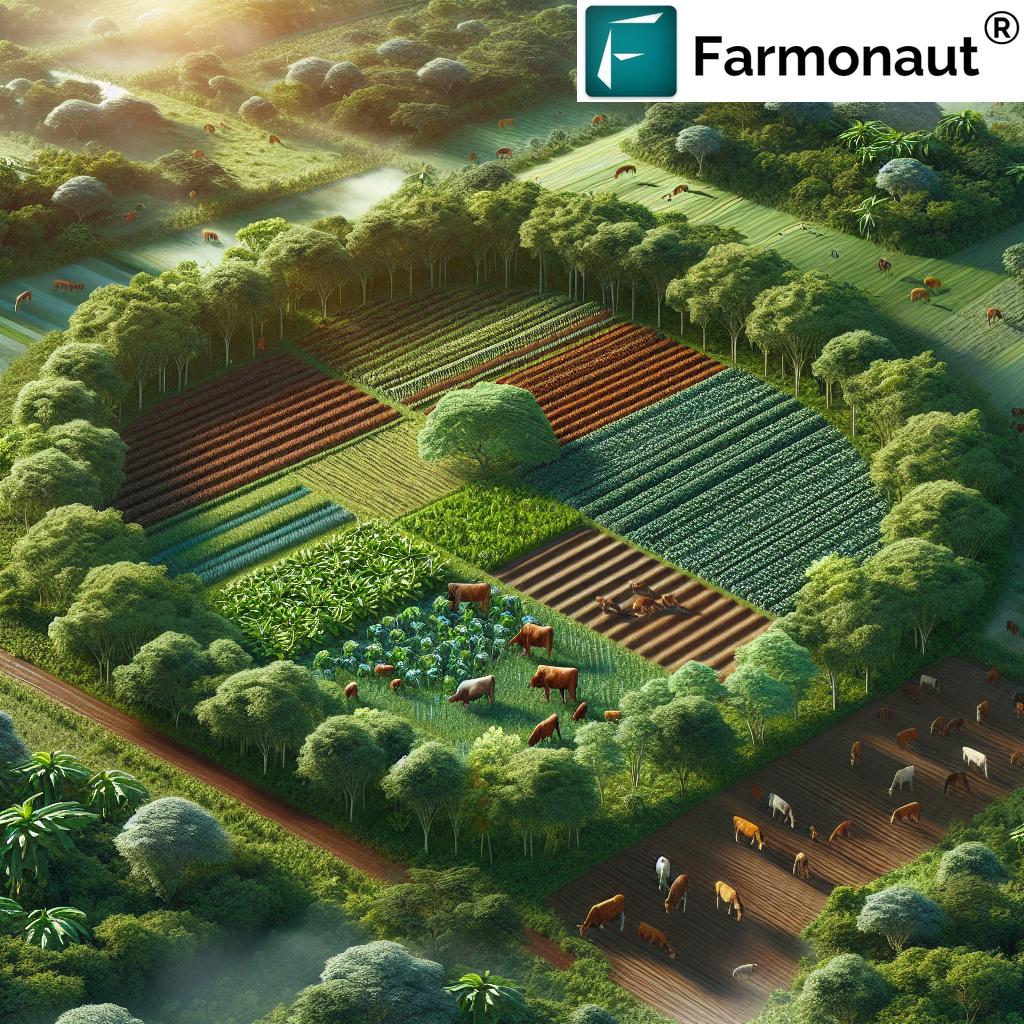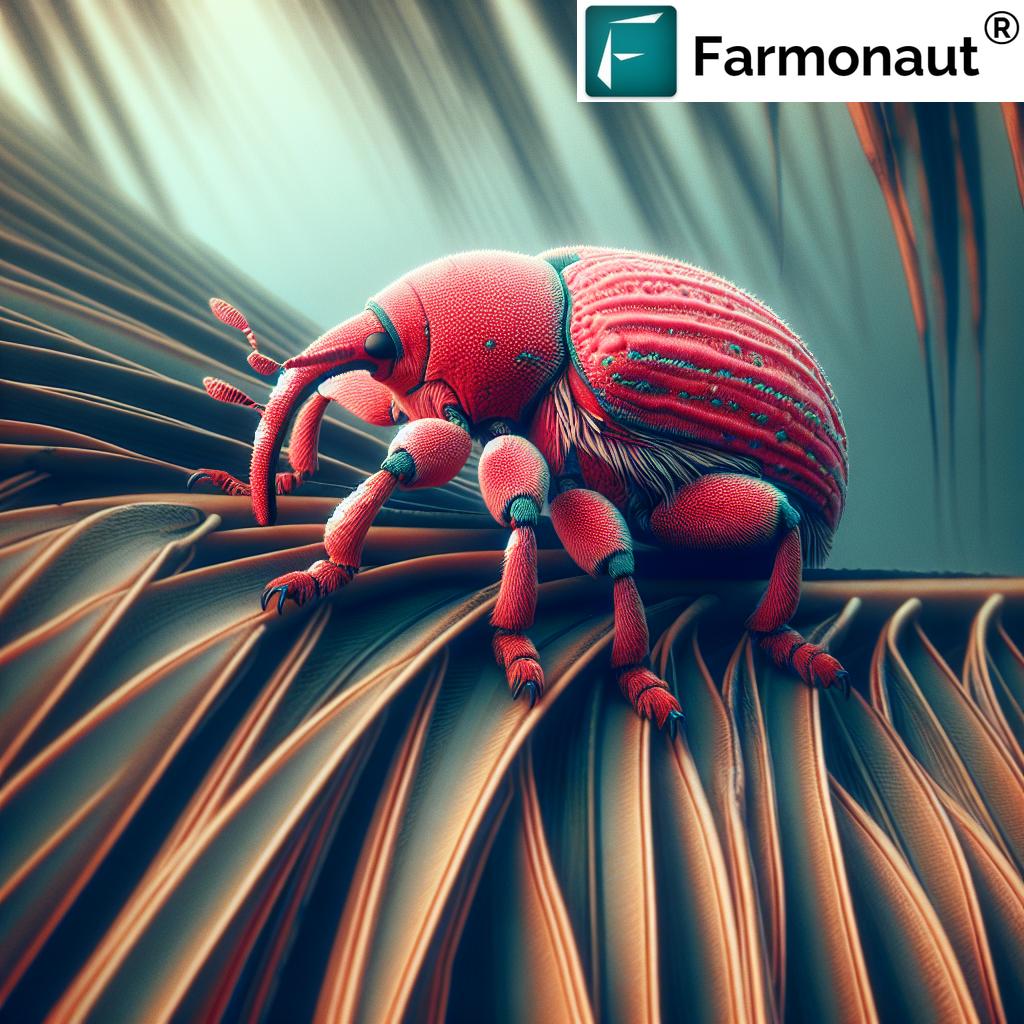Peach Twig Borer Degree Days: 7 Vital Pest Control Tactics
“Peach twig borer larvae cause up to 80% fruit damage if not managed during peak 400-600 degree days.”
Table of Contents
- Introduction to Peach Twig Borer and Degree Days
- Understanding the Biology and Life Cycle of Peach Twig Borer
- Monitoring Peach Twig Borer: Traps, Timelines, and Key Indicators
- Degree-Day Models for Pest Control in Orchards
- 7 Vital Pest Control Tactics for Peach Twig Borer Management
- Degree Day Action Threshold Table
- Farmonaut Tools for Stone Fruit Pest Management
- Frequently Asked Questions
- Conclusion & Resources
Introduction to Peach Twig Borer and Degree Days
Stone fruit production—including peaches, nectarines, and apricots—faces severe challenges from insect pests. Among these, the peach twig borer (Anarsia lineatella Zeller) is notorious for inflicting substantial damage throughout fruit-growing regions like California and beyond. Effectively managing this pest in orchards is crucial for maintaining healthy, productive crops and ensuring high fruit quality.
The peach twig borer thrives by exploiting the tender tissues of stone fruit trees. Its larvae feed on young shoots, causing wilting (“flagging”), and later generations often bore into fruit, risking significant loss. Pivotal to successful management is leveraging advanced strategies: understanding the insect’s life cycle, utilizing degree-day models for pest control, effective monitoring, and implementing timely, integrated control measures.
Growers, orchard managers, and crop advisors seeking sustainable peach twig borer management will benefit from a deep dive into the pest’s biology, precision monitoring approaches, and the tactical interventions outlined in this guide. Let’s equip ourselves to detect, manage, and minimize this pest’s presence in our stone fruit orchards.
Did you know? Farmonaut’s real-time satellite-based crop health monitoring allows orchard growers to visually identify stress zones caused by pest infestations, including areas with high likelihood of peach twig borer activity. This helps prioritize interventions and reduce input wastage, even in large and dispersed orchards.
Understanding the Biology and Life Cycle of Peach Twig Borer
Biology of Peach Twig Borer: Key Features
The peach twig borer is a member of the Gelechiidae family whose larvae pose a significant threat as stone fruit pests. Understanding the pest’s biology and life cycle is critical for timely control. Here’s how the Anarsia lineatella makes its mark in orchards:
- Overwintering Habits: The peach twig borer overwinter as immature larvae in protective cells called hibernaculae. These are snugly located within the crotches of twigs and branches—areas identifiable by small chimneys of frass and wood chips.
- Spring Awakening: With the arrival of early spring (usually near the pink bud stage), these larvae become active. They emerge from hibernaculae and begin feeding aggressively on tender buds and young leaves.
- Shoot Boring and Damage Symptoms: As the season progresses, larvae bore into young shoots. The result is rapid wilting and dieback of growing tips—a phenomenon called “flagging”. This is readily noticeable in affected trees as dying or collapsed shoot ends.
- Fruit Infestation: Later in the cycle, subsequent generations of larvae may either continue to infest shoots or, more destructively, attack the nascent fruit. Feeding on and entering fruit leads to disfiguration and, in severe cases, significant potential loss.
- Lifecycle Continuation: Adult moths emerge and lay eggs, thus initiating another generational cohort and repeating the cycle.
This larvae life cycle in orchards—from overwintering to egg hatch, larval feeding, and adult moth emergence—forms the backbone of all peach twig borer management strategies. The damage is not just cosmetic: heavy infestations can reduce fruit yield by up to 80% if left unchecked, especially between 400–600 degree days.

Identifying Overwintering Larvae and Symptoms
- Search branch crotches and under thin bark for hibernaculae—easily marked by frass (excrement) mixed with wood chips.
- Infested shoots typically show chewed bark at the entry and a buildup of frass at the base of struck shoots or within “chimneys.”
- Early presence of wilted areas on shoot tips is a reliable indicator of active larvae.
Why Understanding Life Cycle Matters for Control
Effective peach twig borer management relies heavily on the predictive modeling of biological stages (egg hatch, larval emergence, etc.) and the timely alignment of control interventions—especially when using degree-day models for pest control.
For orchard managers seeking a technology edge, Farmonaut’s satellite-based monitoring is ideal. Using large-scale farm management tools, growers can schedule manual inspections at orchard zones showing stress, and cross-reference satellite-derived crop health anomalies with possible pest infestations.
Monitoring Peach Twig Borer: Traps, Timelines, and Key Indicators
Monitoring Peach Twig Borer: Why It’s Critical
The cornerstone of effective pest management is early detection. Since peach twig borer populations are often patchy and unpredictable, systematic monitoring in orchards is vital. This means using the right trap types, placement strategies, and regular inspection protocols.
- Pheromone Traps: Mimic the female moth’s scent to attract and detect adult male moths. These should be deployed by early May (or even earlier in warm regions) to capture the season’s first emerging adults.
- Location and Timing: Place traps within tree canopies at eye level, making sure coverage is consistent throughout the orchard.
- Trap Servicing: Check weekly, as regular removal of captured moths ensures ongoing efficacy and the clear identification of a first capture date.
- Trap Data and Degree Day Models: The first adult moth captured triggers the start of degree day accumulation, which is the key reference for synchronizing management activities with the pest’s life cycle.
- Egg and Larval Observations: Visual checks of wilted shoots, flagged branch tips, and fruit damage provide essential real-world feedback to supplement trap counts.
“Monitoring traps can reduce peach twig borer infestations by 60% when checked weekly during critical degree day periods.”

Degree-Day Models for Pest Control in Orchards
Degree-day models are a scientifically validated way of predicting pest developmental events based on temperature accumulation. For peach twig borer management, this means precise timing of scouting and intervention activities. The degree day concept is crucial for making effective, environmentally responsible decisions.
How Degree-Day Models Work
- Lower and Upper Developmental Thresholds: For peach twig borer, the developmental temperature window is 50°F to 88°F. Degree days accumulate only when temperatures fall within this range.
- Calculating Degree Days: Sum the average daily temperatures (minus the lower threshold of 50°F), then accumulate over time starting from the date of first moth trap capture.
- Key Events Predicted by Degree Days: These models help growers anticipate egg hatch, first and subsequent larval generations, and optimal intervention windows.
For instance, if your orchard’s traps caught the first adult moth on May 1, you would begin accumulating degree days from that point. Control measures—like targeted insecticide sprays—can then be accurately timed for peak effectiveness.
On the frontlines of data-driven agriculture, Farmonaut’s Jeevn AI Advisory System analyzes both satellite and weather data to provide personalized pest advisory. Our AI can send prompt notifications for monitoring, intervention, and resource optimization based on projected pest pressure periods in your orchards.
Why Degree-Day Models Are Essential for Pest Control
- Reduces unnecessary pesticide applications by targeting only when larvae are most vulnerable.
- Prevents wasted fruit by intervening before extensive boring and internal fruit damage can occur.
- Supports sustainable agriculture by minimizing non-target effects and chemical resistance.
In the context of stone fruit pests, applying degree-day models allows you to “outsmart” pest generations and preserve your orchard’s health and profitability.
7 Vital Pest Control Tactics for Peach Twig Borer Management
Let’s break down the seven most critical strategies for peach twig borer management. These integrate cultural, biological, chemical, and technological controls to provide a holistic, effective approach for orchards of any scale—including those managing peaches, nectarines, and apricots.
1. Cultural Practices for Pest Management
- Pruning and Destroying Infested Shoots: In early spring, prune off and destroy shoots showing “flagging” or wilted tips—targeting areas just below the damage zone. This directly removes active larvae and stops population buildup.
- Orchard Sanitation: Meticulously inspect branch crotches for hibernaculae and scrape out overwintering larvae. This is highly recommended before bud break and after harvest.
- Eliminate Habitat: Remove excess brush piles or pruned wood where larvae might shelter through winter.
These cultural controls lower initial pest pressure and can complement—or, in low-pressure years, even substitute for—chemical interventions.
2. Biological Control of Fruit Borers
- Leverage Natural Enemies: Encourage populations of parasitic wasps (including the Chalcididae family) and Formica ants, as they help to suppress peach twig borer larvae and reduce reliance on synthetic controls.
- Reduce Broad-Spectrum Pesticide Use: Avoid broad-spectrum chemicals during periods of wasp activity to preserve these key biological allies.
In California stone fruit orchards, the biological control of fruit borers with natural enemies has been shown to result in significant larval destruction in favorable seasons.
3. Chemical Control Timing for Borers
- Degree-Day Based Applications: Target synthetic or low–impact insecticide sprays when accumulated degree days hit the predicted windows for larval hatchings—usually just before they bore into shoots or fruit.
- Minimize Non-Target Effects: Spot-spray only orchard zones with confirmed activity, using monitoring data and visual inspection as guidance.
- Follow Threshold Guidelines: Adhere to local extension recommendations (often at 400–600 degree days) for first and subsequent applications, aligned precisely to your orchard’s environment.
Chemical control timing for borers is a classic IPM example—only treat when necessary, and time applications for peak impact with minimal residue concerns.
4. Integrated Pest Management (IPM) Integration
- Combine Multiple Tactics: Integrate cultural, biological, and chemical controls with regular monitoring for the most sustainable, cost-efficient approach.
- Record Results: Keep detailed records of trap captures, degree day tallies, and observed pest presence for future season improvements.
IPM Benefits for Stone Fruit Pest Management
- Reduces chemical resistance risk by varying control methods.
- Encourages orchard resiliency and overall tree vigor.
5. Farmonaut Satellite-Based Solutions
- Real-Time Crop Health Monitoring: Our platform’s multispectral satellite imagery offers visual cues on crop health and stress areas, enabling targeted field scouting for early detection of wilting shoots in peach trees—potentially associated with pest activity.
- AI Advisory and Decision Support: With Jeevn AI, you’ll receive field-specific pest management recommendations based on current satellite and weather data.
- Accessible Across Devices: Satellite monitoring and control strategy guidance are available via Android, iOS, web apps, or directly through our API for business integration.
6. Orchard Hygiene & Sanitation
- Removal of Fallen or Mummified Fruit: Collect and destroy fruit showing signs of internal boring or decay, as larvae may survive and emerge in subsequent seasons if left unchecked.
- Dispose of Pruned Material Properly: Compost or burn (where allowed) pruned shoots and branches to prevent overwintering pest survival.
7. Technology-Driven Tracking & Record Keeping
- Digital Mapping: Use mapping tools from Farmonaut’s fleet management for tracking orchard regions, managing interventions spatially, and optimizing resource allocation.
- Blockchain Traceability: For commercial growers and food processors, blockchain-based traceability can authenticate that fruit was produced using evidence-based, compliant pest management strategies.
Degree Day Action Threshold Table for Peach Twig Borer
Use this table to align your orchard’s degree day tallies with key biological events and recommended interventions. Note: Begin degree day accumulation upon first moth trap capture.
| Degree Day Range (°F) | Peach Twig Borer Life Stage | Orchard Observations | Recommended Management Actions |
|---|---|---|---|
| 0–100 | Overwintering larvae in hibernaculae | Frass, wood chips, chimneys at shoot crotches | Prune and destroy wilted tips; inspect & remove hibernaculae |
| 100–300 | Adult moths begin to emerge | Traps catch first adult moths | Deploy pheromone traps; begin full orchard monitoring |
| 301–400 | Eggs laid & hatching | Increased shoot tip flagging | Plan chemical/biological control as needed |
| 401–600 | First generation larvae feeding, shoot strikes common | Flagged shoots, larval entry holes | Apply insecticide or disrupt further generations if threshold met |
| 601–900 | Subsequent larval generations, fruit boring possible | Damaged/wilted shoots, early fruit scarring | Continue monitoring; repeat chemical, biological actions as needed |
| 900–1200+ | Potential late season/overlapping generations | Persistent larval signs; possible late fruit damage | Intensify orchard hygiene; target localized interventions |
Farmonaut Tools for Stone Fruit Pest Management
Unlock Precision Orcharding with Farmonaut
- Satellite-Based Crop Health Monitoring: Farmonaut’s platform delivers multi-level, field-specific insights on crop performance and stress—monitoring peach twig borer effects across your orchards seamlessly. Satellite imagery (NDVI and more) highlights patchy decline that may point to pest infestations, enabling timely interventions.
- Jeevn AI Advisory System: Farmonaut’s AI tool analyzes satellite, weather, and field data to forecast pest risk periods, streams customized management advices, and automates alerts for orchard teams.
- Automated Orchard Mapping: With fleet management, map, track and coordinate scouting teams over large areas, and keep control records for compliance and improvement.
- Product Traceability: For commercial fruit brands and exporters, demonstrate blockchain-based product authenticity—showing that fruit passed through degree day-timed management, was monitored accurately, and is sustainably grown.
- Access Across All Devices: Download the Farmonaut app on Android, iOS, or open in your browser for field access, making it easy to manage gigs, alerts, and mapping wherever you are.
All these tools empower stone fruit producers, agronomists, and farm managers to tackle the perennial peach twig borer challenge—modernizing their orchards with data-driven, ecological, and highly focused interventions.
Frequently Asked Questions: Peach Twig Borer Management
Q1: What signs should I look for to detect early peach twig borer infestations?
Look for wilted or “flagged” shoot tips, frass and wood chips around shoot crotches, and small chimneys on branches—signs that larvae are feeding and boring inside. Regular inspection of trap captures and bud tips is highly recommended from early spring onward.
Q2: When should pheromone traps be deployed for monitoring peach twig borer?
Traps should be placed in orchards by early May, or before the season’s predicted first moth emergence for your zone. Trap deployment should coincide with degree day accumulation for best efficacy in monitoring peach twig borer activity.
Q3: How do degree-day models improve chemical control of fruit borers?
Degree-day models allow growers to optimize the time of insecticide application, targeting periods just before larvae enter shoots or fruit. This increases efficacy, reduces pesticide use, and helps maintain beneficial populations (like parasitic wasps).
Q4: Are there non-chemical alternatives to managing peach twig borer?
Yes! Cultural practices (removal and destruction of infested shoots), promoting natural enemies (e.g., parasitic wasps, ants), and diligent orchard hygiene are all effective components of an integrated pest management program.
Q5: Can Farmonaut’s technology help time my pest management interventions?
Absolutely. Our platform’s satellite mapping and AI analysis provide visual cues and tailored advisories, ensuring interventions align with pest risk periods, reducing input waste and optimizing orchard productivity.
Q6: What precautions should I take during harvest to minimize pest issues for next season?
Remove mummified fruit, destroy pruned infested material, and inspect for persistent hibernaculae. Good post-harvest sanitation greatly reduces future peach twig borer populations.
Conclusion & Resources
Managing peach twig borer in stone fruit orchards is a significant but conquerable challenge when armed with scientific principles and precision agriculture tools. Success relies heavily on understanding the biology, timing interventions with degree-day models, using traps to monitor populations, and integrating a full toolkit of cultural, biological, and chemical controls.
By embracing these seven vital pest management tactics—including utilizing advanced solutions like Farmonaut’s real-time crop health monitoring, AI advisories, and traceability—orchard managers boost their ability to deliver high-quality fruit, minimize losses, and promote sustainable, profitable agriculture.
Ready to take your orchard’s pest management to the next level? Explore Farmonaut’s platform—available as a web app, Android, and iOS—for instant access to modern, data-driven orchard management.
References:
- Peach twig borer – Pacific Northwest Extension
- Washington State University Tree Fruit – Peach Twig Borer
- University of California ANR – Peach Twig Borer Monitoring
- Utah State University Extension Peach Twig Borer
Ready to modernize your pest management with Farmonaut?
Start here for breakthrough, satellite-driven, and sustainable orchard management.













